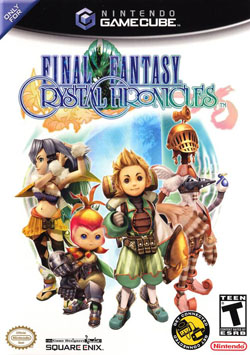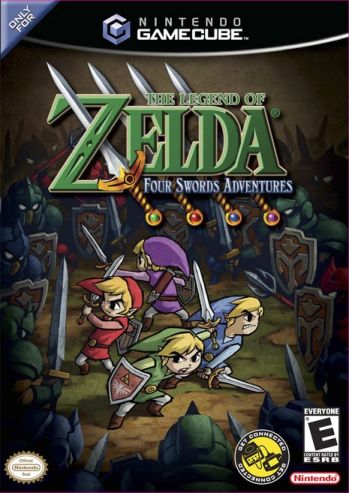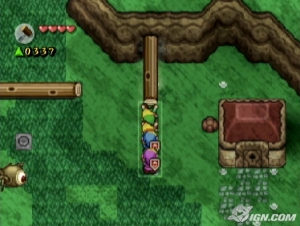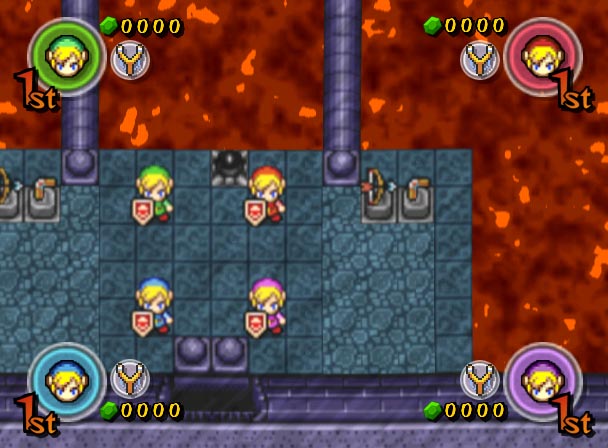CO OP Mechanics and Design pt. 3
 Sunday, November 2, 2008 at 12:43AM
Sunday, November 2, 2008 at 12:43AM At this point you may be wondering if a game can contain multiple types of co-op elements, if these types can occur simultaneously, and how this affects the overall nature of the co-op design. The answer to the first two questions is indubitably.

As a commenter pointed out Final Fantasy: Crystal Chronicles contains level 4:forced cooperation (someone must carry the Crystal Challis) and level 5: boosted mechanics elements. Not only do these co-op elements exists simultaneously, but they also have a degree of interplay between them. While charging magical or physical attacks, the player character(s) become immobile. During this time, if the challis bearer moves the challis, the protective barrier can be moved away from the charging character(s). Once outside the barrier, characters continually take damage. Furthermore, while carrying the challis and charging attacks, one's defensive and mobility options are compromised. To balance, players often assign or take up roles for the good of the team. Because each character has the same core abilities and is able to bear the challis, attack, defend, and switch roles at any time, the overall combat design contains some level 6: organic co-op elements.

Now I want to take the time to discuss the game that I feel is best example of co-op design across the board. The Legend of Zelda: Four Swords is not only a well designed Zelda game, but the gameplay supports up to 4 players while presenting each level of co-op design in melodious flow. Let's take a look.
LEVEL 1) Over the Shoulder/Backseat Playing
- There are times in Four Swords when all the players must maneuver from one area to another. Usually when a player makes it safely to the end of the obstacle course, as they wait for the others to finish, they engage in level 1 co-op activity. The waiting player(s) can provide hints on how to successfully get through or cheer on the remaining players. As long as the waiting player(s) doesn't engage/help with the still struggling player(s) the cooperation remains level 1.

- When all but one of a party moves from playing on the GBA to playing on the TV screen, the opportunity is ripe for backseat co-op. "Come on Green Link. Just jump into the cannon so we can move on." (see above)
LEVEL 2) Alternating Turns
- When a passage is too narrow or it's too dangerous to travel as a group safely, players often take turns progressing. The GBA sections were players must jump into a flying cannon to blast themselves out of the underground cave and back onto the TV screen are a good example of alternating turns co-op design. Only one Link can fit into the cannon at a time. Even when the players attempt to force their way into the cannon, ultimately only one will make it in and the others will have to wait their turn.
- Another interesting example of alternating turns co-op design is when players opt to letting another player carry them around. It's the classic "I'll rest while you carry me and then we'll switch when you get tired" scenario. Though this example is a bit extreme, it did happen in my experience.
LEVEL 3) Separate But Equal, But Still Together

- There are mini games and other scenarios in Four Swords where players don't have significant ways to interact with each other. The Epona sections are a perfect example. In these sections, all players must ride their horses through an obstacle course or through the country side. While riding Epona, the players can't attack, hit, or disturb each other's progress. As long as everyone makes it to the end, the team succeeds. Because the interaction has been removed, players are encouraged to try and collect the most force gems that litter the course. The end result ends up being a counter operative-cooperative race to the finish.
LEVEL 4) Forced Cooperation
- One very simple example is that all four players must move against the edge of the screen in order to travel to the next area (while playing on the TV). Basically, nobody can move on until everyone moves on. There have been times where I had to pick up uncooperative Links and carry them across.

- The number 4 is a governing pattern for Four Swords. With four Links running around, all of the forced cooperation elements were designed so that all four players had to work together. "Four holes. Four swords. Come on guys. It's not that hard." Everything from the four pressure sensitive switches, to four holes in the wall, to the 2x2 stones that requires four Links to lift, to the electric eye switches at the end of most stages follows this governing idea.
- Some puzzles requires all players to work together. When pulling on an object, Link's strength is multiplied times four. This comes in handy when pulling on logs. It's the same when cooperatively pushing on an object as well.
- Some bosses also force players to play cooperatively. The classic energy volley boss design takes on a new level in Four Swords. This time the energy "volleyball" is color coded: Red, Green, Blue, or Purple. When the color of the ball matches your Link color, you're the only one who can send it flying back in the boss's direction. Phantom Gannon, Manhandla, and Big Moldorm are examples of such bosses.
LEVEL 5) Mechanics Boost Incentive
- There are some mechanics and properties of mechanics that Link can only perform with the help of another player. Such mechanics are called co-op mechanics, and they fall under level 5 because the added abilities boost the players basic/core abilities.
- Link has the ability to pick up another Link, carry, and throw him. Link's core abilities don't contain the ability to JUMP. So throwing a link across a gap qualifies as a cooperative boosted mechanic.
- A fully charged arrow can stick to another Link and send him flying in the direction of the arrow. Because this technique doesn't harm the punctured Link and it allows for a unique way to travel long distances (even over gaps), the technique also qualifies for level 5 co-op design.
LEVEL 6) Organic Cooperation
- The majority of the co-op design in Four Swords consists of organic cooperation. Each player is bound by the same rules of space, time, and physicality. To fight with someone, simply move over to them and stand your ground together. To defend a friend, either roll in front of an incoming blast, pick them up and carry them out of danger, or destroy all hostile targets in the vicinity. It's the same natural and organic gameplay from The Legend of Zelda: A Link To The Past times four.
- Another indicator of organic cooperation design is the flexible and dynamic assignment of roles. Unlike in other games where players can pick characters with unique attributes that naturally fit them into a specific role (Team Fortress 2), in Four Swords roles are made and reassigned based around cooperation and core abilities.
- In one section, players have to shoot arrows at targets hidden beyond the top of the screen. The non-shooting players have the option of traveling to the top screen where they can view what happens to the arrows the other Link's are shooting. The "spotter" player can then give instructions to the arrow shooting player on how to adjust their aim as well as when to release the shot. The best part is that the role of the "spotter" can be filled by any player even another arrow wielder.
- When entering a town on a quest to dig up come clues, players can easily assign a house per player. By divding the task into parts and assigning roles, the information from the towns people can be gathered, compiled, and analyzed at a multiplied rate.

- Powerup weapons/items are arranged across the various levels in Four Swords: Boomerang, Bombs, Arrows, Roc's Feather, Hammer, Lantern, and Sling Shot. Sometimes, these powerups come in sets of four so every player can have one. Other times, they come in pairs or even individually. At these moments, taking up a weapon puts that player into a role. If you pick up the only bombs, the team depends on you to blow up every barrier, cracked wall, and Dodongo you come across. Beware, the bombs and lantern fire can hurt fellow players. Also, the boomerang, charged arrow, and lv.2 hammer affect nearby players in non damaging ways. Though the roles are more forced with these powerups, the team attack keeps things very organic.
- The stealth level where all four players must sneak out of jail together is perhaps my favorite cooperative scenario in the entire game. Cooperative play may be on the rise overall in the video game industry, but cooperative stealth is still something that is quite rare. In this level players have a choice of traveling on two paths to escape. All the while a search light sweeps around the field. With any sound, the search light zips over to the source of the noise. Breaking pots using a well aimed boomerang causing a distraction that gives your friend enough time to escape without being spotted is nothign short of genius.
In the end, when playing The Legend of Zelda: Four Swords with three other friends, you will be put through a series of cooperative scenarios consisting of all the different levels outlined on this blog. By using a variety of co-op design in each stage, players can experience varying degrees of freedom while still working as a team. Sometimes you want to work together. Sometimes you want to go on your own. And sometimes you're forced to play as a team. No matter how you look at it, the degree of co-op gameplay variation runs the gamut and taps out a memorable melody in the meantime.


Reader Comments (2)
Since you brought up stealth in your last bullet point, I gotta ask, how many articles do you have on stealth games?
I always found the stealth genre to be interesting but also pretty damn small compared to other genres so it's hard for me to find many examples or inspirations for stealth design.
@ Johnathan
Stealth articles... how about....
http://critical-gaming.squarespace.com/blog/2010/9/8/puji-full-analysis-depth-clarification.html
http://critical-gaming.squarespace.com/blog/2010/12/28/not-a-hecker-heckler.html
There's stealth in almost every Zelda game since OOT. There's some stealth in many shooters too including small moments in Halo reach.
Otherwise, I don't talk about it much. I don't play it that much either. Stealth rocks though.